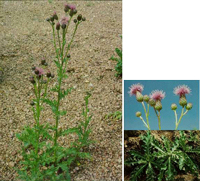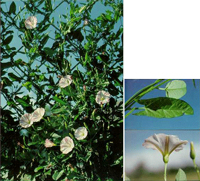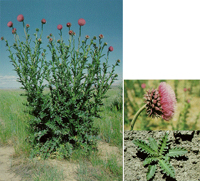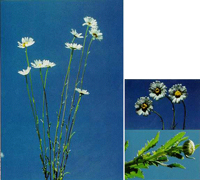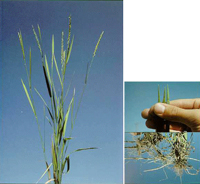Contact Us
Wendy Karol Cecil
Research Associate, Plant Sciences
University of Wyoming
1000 E. University
Agriculture Bldg 4031
Laramie, WY 82071
Phone: (307) 766-2243
Email: wcecil@uwyo.edu
Weeds Study Guides
Wyoming FFA Agronomy Contest
Noxious Weeds
Click on image for full size picture.
Canada Thistle
|
Asteraceae (Sunflower family) Canada thistle is a colony-forming perennial from deep and extensive horizontal roots. Stems are 1 to 4 feet tall, ridged, branching above. Leaves are alternate, lacking petioles, oblong or lance-shaped, divided into spiny-tipped irregular lobes. Flowers are unisexual, on separate plants; flowers purple (occasionally white) in heads 1/2 to 3/4 inch in diameter; involucral bracts spineless. Fruits are about 1/8 inch long, somewhat flattened, brownish, with a tuft of hairs at the top. Canada thistle is a native of southeastern Eurasia. It was introduced to Canada as a contaminant of crop seed as early as the late 18th century. Canada thistle differs from other species of the true thistle in that there are male and female flower heads, and these are on separate plants. By asexual reproduction, it is possible that a colony of male plants would produce no fruits, but still maintain itself. This aggressive weed is difficult to control; for example, breaking up the roots by plowing only serves to increase the number of plants. Flowering occurs during July and August. |
Field Bindweed
|
Convolvulaceae (Morning-glory family) Field bindweed is a perennial from an extensive root system, often climbing or forming dense tangled mats. Stems are prostrate, 1 to 4 feel long. Leaves alternate, more or less arrowhead-shaped, pointed or blunt lobes at the base. The flowers are bell-or trumpet-shaped, whit to pinkish, approximately 1 inch in diameter with 2 small bracts located 1 inch below the flower. Fruit is a small, round capsule, usually 4-seeded. Field bindweed was introduced from Europe and has become a widespread and serious weed problem in all parts of the U.S. except the southeastern states. In the western United States, it is extensively distributed in cultivated fields and waste places. Because of its remarkable adaptability to different environmental conditions, it may be found at altitudes as high as 10,000 feet. it is a difficult weed to eradicate because of the long, deep taproot which can penetrate the soil to a depth of 10 feet and which gives rise to numerous long lateral roots. Seeds remain viable for up to 50 years. The flowering period is from late june until frost in the fall. |
Musk Thistle
|
Asteraceae (Sunflower family) Musk thistle is biennial or sometimes a winter annual, which grows up to 6 feet tall. Leaves are dark green with light green midrib, deeply lobed, and spiny margined. Leaves extend onto the stem giving a winged appearance. Flower heads are terminal, solitary, 1 1/2 to 3 inches in diameter, and usually bent over. Flowers are deep rose, violet or purple, occasionally white; they are subtended by broad, spine-tipped bracts. Fruits are 3/16 inch long, shiny, yellowish-brown with a plum of white hairlike fibers. Musk thistle was introduced to the U.S. in the early part of the century and is now widespread throughout the U.S. and Canada. It is native to southern Europe and Western Asia. It invades pasture, range and forest lands along with roadsides, waste areas, ditch banks, stream banks and gain fields. It spreads rapidly forming extremely dense stand which crowd out desirable forages. Chemical control is effective. An introduced biological control agent, the musk thistle weevil, feeds on the seeds and cn limit the spread of this plant. |
Oxeye Daisy
|
Asteraceae (Sunflower family) Oxeye daisy is an erect rhizomatous perennial, 10 to 24 inches tall, glabrous to sparsely hairy. Leaves progressively reduce in size upward on stem. Basal and lower stems leaves are oblanceolate to narrowly obovate, 2 to 5 inches long including the petiole, margin crenate to lobed or parted. Upper leaves become sessile and merely toothed. Flowering heads are solitary at the ends of branches, about 1 1/2 inches long. Fruits have about 10 ribs. Oxeye daisy is a native of Eurasia and has escaped cultivation. I can be found in meadows, roadsides, and waste places. Flowering occurs from June through August. |
Quackgrass
|
Poaceae (Grass family) Quackgrass ia an aggressive perennial grass reproducing by seed, or spreading by a shallow mass of long, slender, branching rhisomes. Rhizomes are usually yellowish-white, sharp-pointed, somewhat fleshy. They are able to penetrate hard soils or even tubers and roots of other plants. Stems are erect and usually 1 to 3 feet tall. Leaf blades are 1/4 to 1/2 inch wide, flat, pointed and have small auricles (ear-like appendages) at the junction of blade and sheath. Leaf sheaths and the upper surface of leaf blades may be thinly covered with soft hairs. Spikelets are arranged in two long rows, borne flatwise to the stem. florets are ownless, or with short straight awns. Quackgrass was introduced from the Mediterranean area. It has spread over much of North America, adapting well to moist soils in cool temperate climates. Quackgrass reduces productivity in crops, rangeland and pasture. it is also a nuisance in lawns, ornamentals and home gardens and is believed to be allelopathic. Because of the ability of broken rhisome segments to grow and produce new plants, it is extremely difficult to control mechanically. |
Contact Us
Wendy Karol Cecil
Research Associate, Plant Sciences
University of Wyoming
1000 E. University
Agriculture Bldg 4031
Laramie, WY 82071
Phone: (307) 766-2243
Email: wcecil@uwyo.edu

